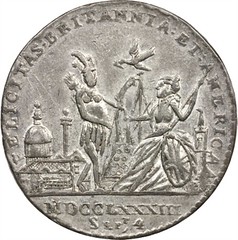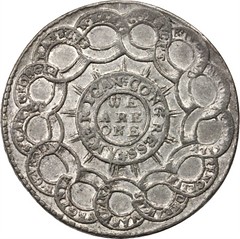
PREV ARTICLE
NEXT ARTICLE
FULL ISSUE
PREV FULL ISSUE
NEXT STEPS FOR CONTINENTAL DOLLAR RESEARCHIn May we discussed the article on "The Myth of the Continental Dollar" by Erik Goldstein and David McCarthy in the
January 2018 issue of The Numismatist, the official journal of the American Numismatic Association. The July 2018 issue contains the second
part, authored by Goldstein alone. With permission, below is an excerpt of the final section of the article outlining a number of additional research
questions. -Editor
Having set out to replace erroneous and presumptive statements about the Continental Dollar with provable truths, I have taken this study as far as possible for now. Many questions cannot be answered at this point. In the absence of hard evidence, any further hypotheses could lead to a fresh layer of theoretical baloney. I want to avoid this at all cost, so I offer no speculation here. Instead, I'd like to encourage the pursuit of additional facts by posing a few queries. Some of these relate to flawed suppositions of the past and might seem rhetorical or, at best, the beating of dead horses. Regardless, exploring them could prove to be a useful and enjoyable exercise in critical thinking... and therefore worthwhile. As possible answers and clues arise regarding the following, they surely will bring fresh questions: • Who was "EG," the person who created at least one Continental Dollar obverse die? Now that we know the search has long focused on the wrong side of the Atlantic, we can begin to look for him in 1780s England or Europe. • As off-metal strikes of a common pewter medal, did the brass and silver examples play a historic or numismatic role? • Other than the explanatory flyer saved by Sarah Sophia Banks (an artifact that now resides in the British Museum), do other examples exist and are they identical to hers? • How do these Continental Dollar medals relate to the pewter "Felicitas Britannia et America" medals (Betts-614) struck in England after September 1783? Not only do the two share a common reverse design and lack a copper "scavenger," but both also have milled edges, making them strikingly similar. • Can the dies used to impress the edges of the Betts-614 medals be linked to those used on any varieties of the Continental Dollar? • Why do no Revolutionary War-era newspapers mention a circulating, Congressionally authorized pewter dollar? This absence stands in stark contrast to the innumerable times that diverse aspects of Continental paper money were discussed. Money was as fascinating to newspaper readers then as it is now. • Why have none of these pewter pieces been excavated from campsites occupied by the Continental Army during the Revolutionary War? Collectively, these sites have yielded thousands of pewter buttons and countless copper and small silver coins. Since one of the main purposes of the Continental Currency was to pay troops, huge quantities of the money went directly to the military. One would think if a Congressionally sanctioned pewter dollar circulated after mid-1776, then a good place to look for a lost or discarded example should be the site of a Continental Army encampment, home to thousands of soldiers for months or years on end. • The Continental Congress conducted a majority of its materials-based business in the Philadelphia area, and its paper money, from A to Z, was produced by local tradesmen. Though David Rittenhouse supplied the first 36 "cutts" 30 for the Continental Currency plates in 1775, we don't know who supplied those employed for the February 1776 fractional bills. However, other convenient options existed. Philadelphia had many of the best engravers and metalworkers in 18th-century America, like James Smithers, who made cuts for some currency issues. Other highly skilled mechanics, like silversmith Joseph Richardson, produced the dollar-size 1756 "Kittanning Destroyed" and the 1757 "Treaty of Easton" medals, the first such items struck in British America. Even the dies Richardson used were Philadelphia-made, from the hand of clockmaker Edward Duffield. One might wonder why the Continental Congress would turn to Gallaudet in New York City, a hundred miles and a few days' travel away, when it had a plethora of more talented craftsmen with a greater array of skills right in its backyard. • The suggestion that the Continental Congress was producing coins in secrecy to avoid trouble with the British makes no sense. Other far more "treasonous" activities were extensively documented in its records, like the active support of rebellious troops (the Continental Army) and the issuance of "Letters of Marque," which authorized patriotic American sea captains to prey on British shipping anywhere in the world. While Congressionally licensed pirates were a clear and present danger to Great Britain, the striking of base-metal coins during wartime posed no threat to the Crown Forces or the empire's economy. And would the production of such coins be deemed more treasonous than the printing of Continental Currency or, for that matter, the dispatching of the Declaration of Independence to King George III? Many thanks to Numismatist Editor Barbara Gregory for sharing the article's text and image.
Can our readers help with any of these? Are there possible matches for an engraver with the initials E.G. active in 1780s England or Europe? And what more do we know about the maker of the Felicitas Britannia et America medals? -Editor   To read the complete article, see: To read the earlier E-Sylum article, see:  Wayne Homren, Editor The Numismatic Bibliomania Society is a non-profit organization promoting numismatic literature. See our web site at coinbooks.org. To submit items for publication in The E-Sylum, write to the Editor at this address: whomren@gmail.com To subscribe go to: https://my.binhost.com/lists/listinfo/esylum All Rights Reserved. NBS Home Page Contact the NBS webmaster 
|
